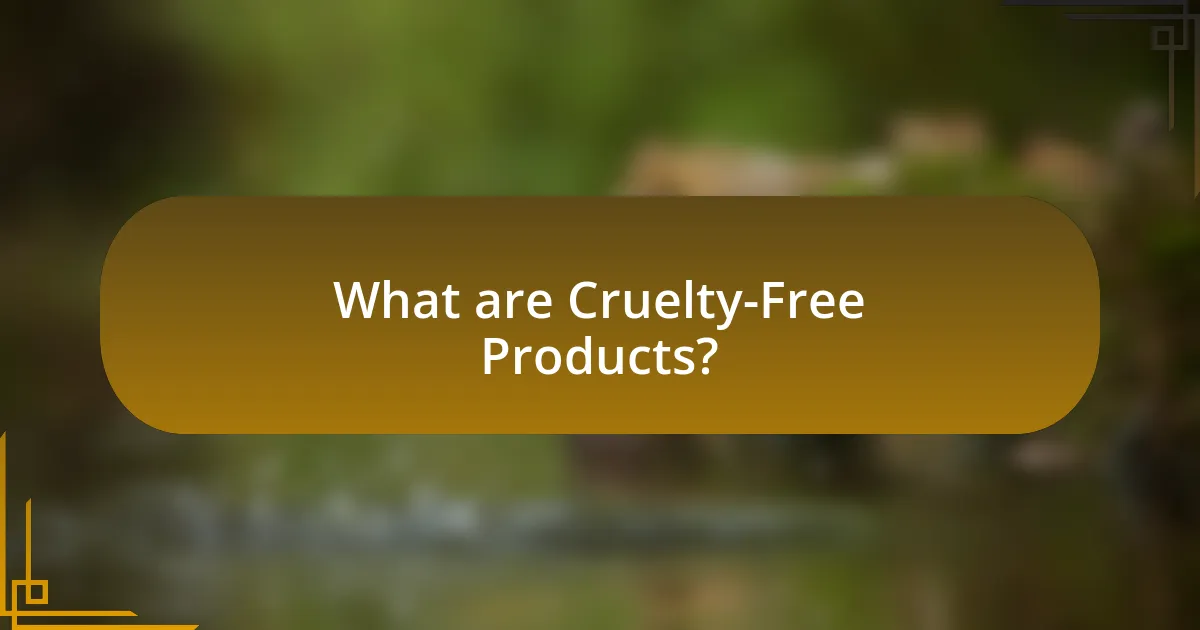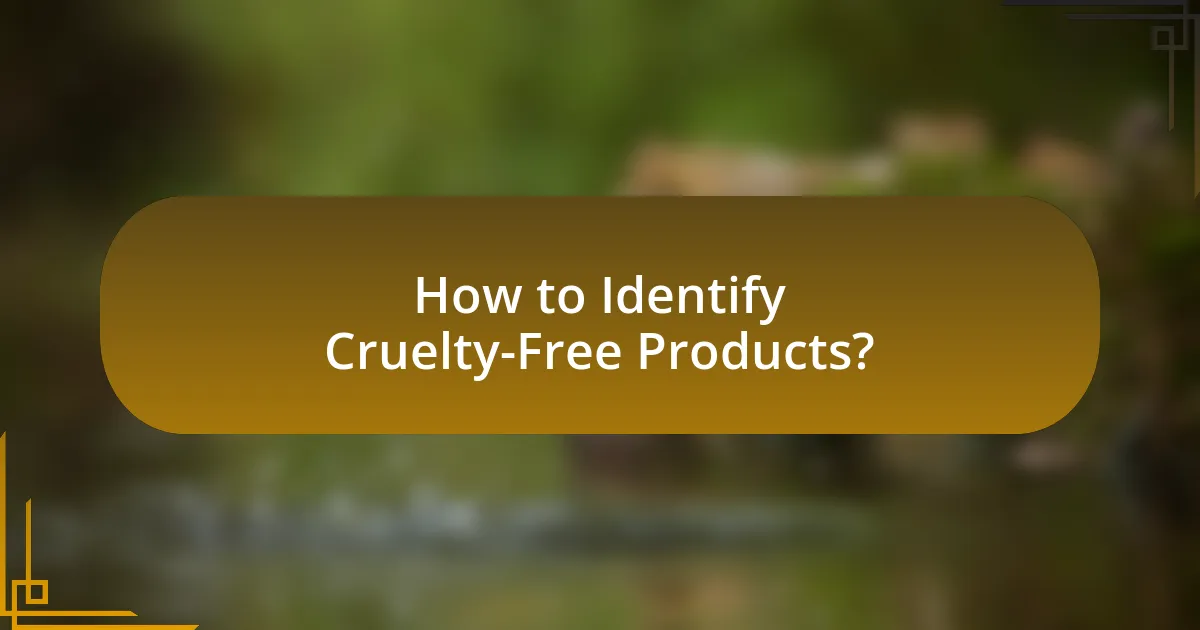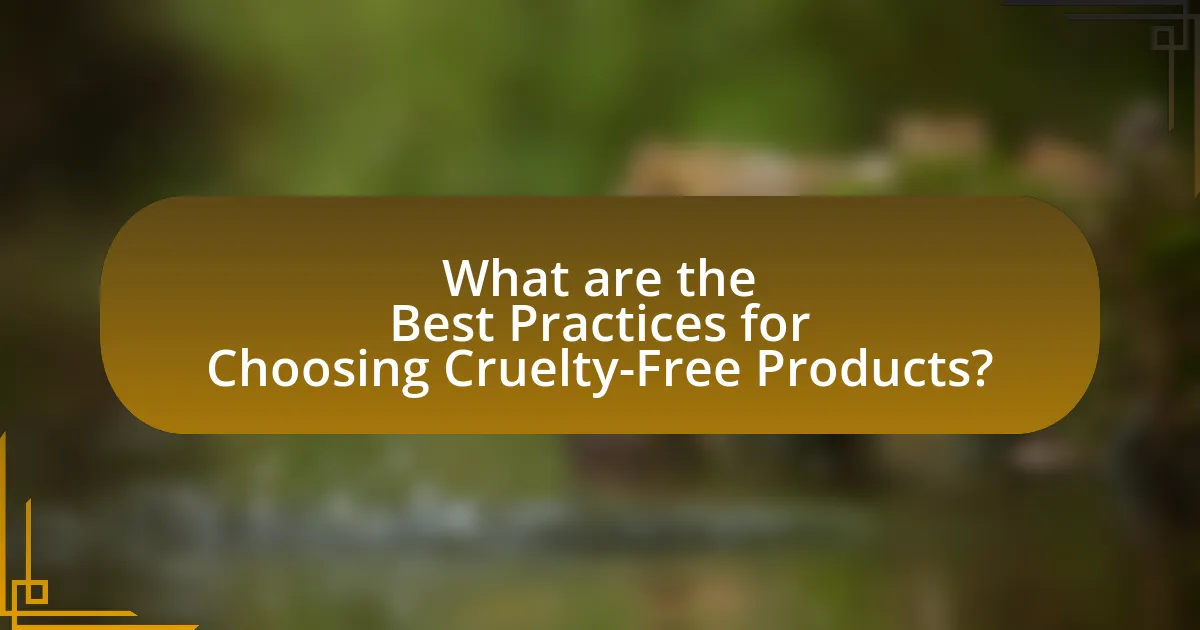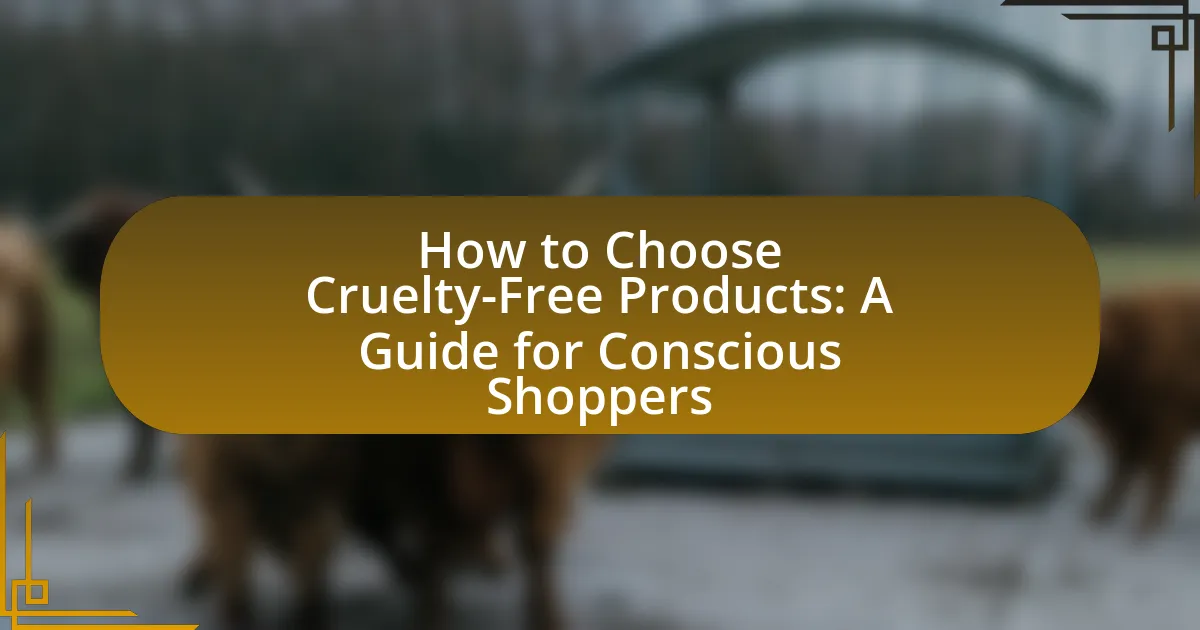Cruelty-free products are defined as items that have not undergone any animal testing during their development, including both ingredients and final formulations. This guide outlines the criteria for identifying cruelty-free products, the significance of various certifications, and the ethical considerations surrounding animal testing. It emphasizes the importance of choosing cruelty-free options to promote animal welfare and discusses common misconceptions, effective research strategies, and best practices for conscious shopping. Additionally, it addresses challenges faced by consumers and highlights the role of consumer choices in advancing cruelty-free practices within the beauty and personal care industry.

What are Cruelty-Free Products?
Cruelty-free products are items that have not been tested on animals at any stage of their development. This definition is supported by various organizations, such as the Humane Society International, which states that cruelty-free products are those that do not involve animal testing for their ingredients or final formulations. The movement towards cruelty-free products has gained momentum, with many consumers seeking alternatives that align with ethical standards regarding animal welfare.
How are cruelty-free products defined?
Cruelty-free products are defined as items that have not been tested on animals at any stage of their development. This definition encompasses both the final product and the individual ingredients used in the formulation. The cruelty-free designation is often verified by certifications from organizations such as Leaping Bunny or PETA, which ensure that companies adhere to strict no-animal-testing policies.
What criteria must a product meet to be considered cruelty-free?
A product must meet specific criteria to be considered cruelty-free, primarily that it has not been tested on animals at any stage of its development. This includes both the final product and its ingredients. Additionally, the product should not be sold in markets where animal testing is required by law, such as in mainland China. Organizations like the Leaping Bunny and PETA provide certifications that verify a product’s cruelty-free status, ensuring compliance with these standards.
How do different certifications impact the definition of cruelty-free?
Different certifications significantly influence the definition of cruelty-free by establishing specific criteria that products must meet to be labeled as such. For instance, certifications like Leaping Bunny and PETA’s Beauty Without Bunnies require that no animal testing occurs at any stage of product development, including ingredients. These certifications provide consumers with assurance that the products they purchase adhere to strict ethical standards, as they are backed by rigorous auditing processes. Additionally, the presence of multiple certifications can create confusion among consumers, as each may have varying definitions and requirements for cruelty-free status, leading to a lack of standardization in the marketplace.
Why is choosing cruelty-free products important?
Choosing cruelty-free products is important because it promotes ethical treatment of animals and supports humane practices in the beauty and consumer goods industries. The use of cruelty-free products ensures that no animals are subjected to testing or harm for the sake of product development, aligning consumer choices with animal welfare values. According to the Humane Society International, over 100 million animals are estimated to be killed in U.S. laboratories each year for testing purposes. By opting for cruelty-free products, consumers can contribute to reducing this number and encourage companies to adopt more humane practices.
What ethical considerations are involved in animal testing?
Ethical considerations in animal testing primarily revolve around the welfare of animals, the necessity of using animals for research, and the potential for alternative methods. The welfare of animals is a significant concern, as testing can cause pain, suffering, and distress to the subjects involved. The necessity of animal testing is often justified by the need for safety and efficacy in products, particularly in pharmaceuticals and cosmetics, where human health is at stake. However, the ethical debate intensifies when considering the availability of alternative methods, such as in vitro testing and computer modeling, which can reduce or eliminate the need for animal subjects. The ethical framework also includes the principles of the 3Rs: Replacement, Reduction, and Refinement, which aim to minimize animal use and improve animal welfare in research settings.
How does the cruelty-free movement impact the beauty and personal care industry?
The cruelty-free movement significantly influences the beauty and personal care industry by driving consumer demand for products that are not tested on animals. This shift has led many brands to reformulate their practices, resulting in an increase in cruelty-free certifications and transparency regarding testing methods. According to a 2021 report by the market research firm Grand View Research, the global cruelty-free cosmetics market is expected to reach $12.5 billion by 2025, reflecting a growing consumer preference for ethical products. Consequently, major companies are now prioritizing cruelty-free policies to attract and retain customers, thereby reshaping industry standards and practices.
What are the common misconceptions about cruelty-free products?
Common misconceptions about cruelty-free products include the belief that all cruelty-free products are vegan, that cruelty-free certification guarantees ethical sourcing, and that cruelty-free products are always more expensive. While cruelty-free indicates no animal testing, it does not imply the absence of animal-derived ingredients. Additionally, not all cruelty-free brands are certified, leading to potential ethical discrepancies. Lastly, many cruelty-free products are competitively priced, debunking the myth that ethical choices must be costly.
Is it true that all natural products are cruelty-free?
No, it is not true that all natural products are cruelty-free. While many natural products are made without animal testing, the term “natural” does not guarantee that a product has not been tested on animals. For example, some brands may use natural ingredients but still engage in animal testing practices. According to the Humane Society International, cruelty-free certification is a separate standard that specifically addresses animal testing, and not all natural products meet this criterion. Therefore, consumers should look for specific cruelty-free certifications to ensure that a product aligns with their ethical standards.
Do cruelty-free products perform as well as traditional products?
Cruelty-free products can perform as well as traditional products, depending on the formulation and brand. Many cruelty-free brands invest in research and development to ensure their products meet or exceed the performance of conventional alternatives. For instance, a study published in the Journal of Cosmetic Science found that cruelty-free cosmetics often utilize innovative ingredients that can enhance efficacy, demonstrating that performance is not inherently linked to animal testing.

How to Identify Cruelty-Free Products?
To identify cruelty-free products, look for certifications from recognized organizations such as Leaping Bunny or PETA, which verify that no animal testing was conducted at any stage of product development. Additionally, check the ingredient list and company policies; brands that openly state they do not test on animals and use cruelty-free labels are more likely to adhere to these practices. Researching the brand’s history and reputation can also provide insight, as companies with a commitment to ethical practices often have transparent information available on their websites.
What labels should you look for on products?
Look for labels such as “Cruelty-Free,” “Not Tested on Animals,” and “Leaping Bunny Certified” on products. These labels indicate that the product has not been tested on animals at any stage of production. The “Leaping Bunny” certification, for example, is recognized internationally and ensures that companies adhere to strict cruelty-free standards. Additionally, the “PETA Approved” logo signifies that a product meets PETA’s criteria for cruelty-free practices. These labels help consumers identify products that align with ethical shopping values.
What do different cruelty-free certifications mean?
Different cruelty-free certifications indicate varying levels of commitment to not testing products on animals. For example, the Leaping Bunny certification signifies that a brand adheres to a strict no-animal-testing policy and is regularly audited to ensure compliance. The PETA cruelty-free logo also indicates that a brand does not test on animals, but it may not require the same level of third-party verification as Leaping Bunny. Additionally, the Choose Cruelty-Free certification involves a comprehensive application process and ongoing monitoring to ensure that companies maintain cruelty-free practices. Each certification provides consumers with assurance regarding the ethical standards of the products they purchase, reflecting the brand’s commitment to animal welfare.
How can you verify a brand’s cruelty-free status?
To verify a brand’s cruelty-free status, check for certifications from recognized organizations such as Leaping Bunny or PETA. These organizations have strict criteria that brands must meet to be labeled as cruelty-free, including no animal testing at any stage of product development. Additionally, review the brand’s official website for transparency regarding their testing policies and practices. Brands that are genuinely cruelty-free often provide detailed information about their commitment to animal welfare, including any third-party certifications they hold.
How can you research brands effectively?
To research brands effectively, start by examining their official websites for transparency regarding their cruelty-free status and ethical practices. Look for certifications from recognized organizations such as Leaping Bunny or PETA, which validate a brand’s commitment to cruelty-free standards. Additionally, utilize consumer reviews and third-party resources like Ethical Consumer or Cruelty-Free Kitty to gather insights on brand practices and customer experiences. This approach ensures that you are informed about the brand’s ethical stance and product sourcing, allowing for a more conscious purchasing decision.
What online resources are available for finding cruelty-free brands?
Online resources for finding cruelty-free brands include websites like PETA’s Beauty Without Bunnies, Leaping Bunny, and Ethical Elephant. PETA’s Beauty Without Bunnies provides a searchable database of companies that do not test on animals, while Leaping Bunny offers a comprehensive list of certified cruelty-free brands. Ethical Elephant features reviews and guides on cruelty-free products, helping consumers make informed choices. These resources are widely recognized for their accuracy and reliability in identifying cruelty-free brands.
How can social media influence your choices in cruelty-free shopping?
Social media can significantly influence choices in cruelty-free shopping by providing access to information, community support, and brand transparency. Platforms like Instagram and Twitter allow users to share reviews, experiences, and recommendations regarding cruelty-free products, which can shape perceptions and purchasing decisions. For instance, a study by the Pew Research Center found that 69% of adults in the U.S. use social media, making it a powerful tool for spreading awareness about ethical shopping practices. Additionally, brands often use social media to showcase their cruelty-free certifications and ethical practices, enhancing consumer trust and encouraging purchases.

What are the Best Practices for Choosing Cruelty-Free Products?
To choose cruelty-free products effectively, consumers should look for certifications from reputable organizations, such as Leaping Bunny or PETA, which verify that products are not tested on animals. Additionally, researching brands’ policies on animal testing and reading ingredient labels can help ensure that products align with cruelty-free standards. According to a 2021 survey by the Humane Society International, 70% of consumers prefer products that are cruelty-free, highlighting the growing demand for ethical shopping practices.
How can you make informed decisions while shopping?
To make informed decisions while shopping, particularly for cruelty-free products, consumers should research brands and their animal testing policies. This involves checking for certifications from recognized organizations like Leaping Bunny or PETA, which verify that products are cruelty-free. Additionally, reading ingredient labels and understanding the sourcing of materials can help ensure ethical choices. According to a 2021 survey by the American Society for the Prevention of Cruelty to Animals (ASPCA), 70% of consumers prefer cruelty-free products, highlighting a growing demand for transparency in shopping.
What questions should you ask before purchasing a product?
Before purchasing a product, you should ask whether the product is certified cruelty-free, what ingredients are used, and if the brand has a transparent animal testing policy. These questions help ensure that the product aligns with ethical standards regarding animal welfare. For instance, a product labeled with a recognized cruelty-free certification, such as the Leaping Bunny or PETA’s cruelty-free logo, indicates that it has not been tested on animals. Additionally, understanding the ingredients can reveal if any components are derived from animal sources, which may contradict cruelty-free principles. Lastly, a brand’s transparency about its animal testing practices can provide insight into its commitment to ethical sourcing and production.
How can you support cruelty-free brands through your purchases?
You can support cruelty-free brands through your purchases by choosing products that are certified cruelty-free, which means they are not tested on animals. Many cruelty-free brands display certifications from organizations like Leaping Bunny or PETA, indicating their commitment to ethical practices. By purchasing these products, you contribute to the demand for humane treatment of animals in the cosmetics and personal care industries. Additionally, supporting cruelty-free brands can lead to increased market share for these companies, encouraging more brands to adopt cruelty-free policies.
What are some tips for transitioning to a cruelty-free lifestyle?
To transition to a cruelty-free lifestyle, start by researching brands that do not test on animals and prioritize those with cruelty-free certifications, such as Leaping Bunny or PETA’s Beauty Without Bunnies. This approach ensures that the products you choose align with your ethical values. Additionally, gradually replace your current products with cruelty-free alternatives, focusing on one category at a time, such as skincare or makeup, to make the transition manageable. According to a survey by the Humane Society International, 70% of consumers are willing to pay more for cruelty-free products, indicating a growing market for ethical choices.
How can you gradually replace non-cruelty-free products?
To gradually replace non-cruelty-free products, start by identifying and assessing the products you currently use that are not cruelty-free. Once identified, prioritize replacing these items with cruelty-free alternatives as they run out. Research brands that are certified cruelty-free by organizations like Leaping Bunny or PETA, ensuring they align with your values. Additionally, consider purchasing from local or smaller brands that emphasize ethical practices. This method allows for a sustainable transition without waste, as you will only buy new products when necessary.
What resources can help you stay committed to cruelty-free shopping?
To stay committed to cruelty-free shopping, utilize resources such as cruelty-free product databases, mobile apps, and certification labels. Websites like PETA’s “Beauty Without Bunnies” and the Leaping Bunny Program provide comprehensive lists of brands that do not test on animals. Mobile apps like “Cruelty-Free” and “Think Dirty” allow consumers to scan products for cruelty-free status while shopping. Additionally, look for certification labels on packaging, such as the Leaping Bunny logo, which indicates adherence to cruelty-free standards. These resources collectively support informed purchasing decisions and promote a cruelty-free lifestyle.
What are the common challenges faced by conscious shoppers?
Conscious shoppers commonly face challenges such as limited product availability, higher prices, and difficulty in verifying product claims. Limited product availability occurs because many retailers do not stock a wide range of cruelty-free or ethically sourced products, making it hard for shoppers to find suitable options. Higher prices are often associated with ethical brands, as they may use more sustainable materials and fair labor practices, which can deter budget-conscious consumers. Additionally, verifying product claims can be complicated due to misleading labeling and a lack of transparency from some brands, making it challenging for shoppers to ensure they are making truly ethical choices.
How can you deal with limited availability of cruelty-free products?
To deal with limited availability of cruelty-free products, consumers can seek alternative brands that prioritize ethical practices. Research indicates that the global market for cruelty-free cosmetics is growing, with a 2021 report by Grand View Research showing a projected CAGR of 6.2% from 2021 to 2028, indicating increasing consumer demand for such products. Additionally, shoppers can utilize online resources and databases, such as the Leaping Bunny or PETA’s cruelty-free list, to identify brands that align with their values. Engaging with local retailers to express demand for cruelty-free options can also encourage them to stock more of these products.
What strategies can help you overcome budget constraints while shopping cruelty-free?
To overcome budget constraints while shopping cruelty-free, prioritize purchasing from brands that offer affordable cruelty-free options. Many companies, such as e.l.f. Cosmetics and The Ordinary, provide high-quality products at lower price points, making cruelty-free shopping accessible. Additionally, utilizing sales, discounts, and coupons can significantly reduce costs; for instance, many cruelty-free brands frequently run promotions or offer loyalty programs that reward repeat customers. Shopping at discount retailers or online platforms that specialize in cruelty-free products can also yield savings, as they often have lower prices compared to traditional retail outlets. Lastly, consider buying in bulk or choosing multi-use products, which can provide better value and reduce overall spending while maintaining a commitment to cruelty-free practices.
What are the key takeaways for conscious shoppers?
Conscious shoppers should prioritize products that are certified cruelty-free, ensuring that no animal testing was involved in their development. They should research brands and their practices, looking for transparency in sourcing and production. Additionally, conscious shoppers can support companies that engage in ethical practices, such as sustainable sourcing and fair labor conditions. According to the Humane Society International, over 1,500 companies are certified cruelty-free, providing a reliable reference for consumers. By choosing these products, shoppers contribute to a market that values animal welfare and ethical standards.
How can you stay informed about new cruelty-free products and brands?
To stay informed about new cruelty-free products and brands, regularly follow reputable cruelty-free certification organizations such as Leaping Bunny and PETA. These organizations provide updated lists of certified brands and products, ensuring that consumers have access to the latest information. Additionally, subscribing to newsletters from cruelty-free beauty blogs and websites can deliver timely updates on new product launches and brand announcements directly to your inbox. Engaging with social media platforms where cruelty-free brands promote their products can also keep you informed about new offerings and promotions.
What role do consumer choices play in promoting cruelty-free practices?
Consumer choices significantly influence the promotion of cruelty-free practices by driving demand for ethical products. When consumers prioritize cruelty-free items, companies respond by adopting humane practices to meet market expectations. For instance, a 2020 survey by the Humane Society International found that 70% of consumers are willing to pay more for products that are not tested on animals, indicating a clear market trend towards cruelty-free options. This consumer behavior encourages brands to reformulate their practices, leading to a broader industry shift towards cruelty-free standards.
